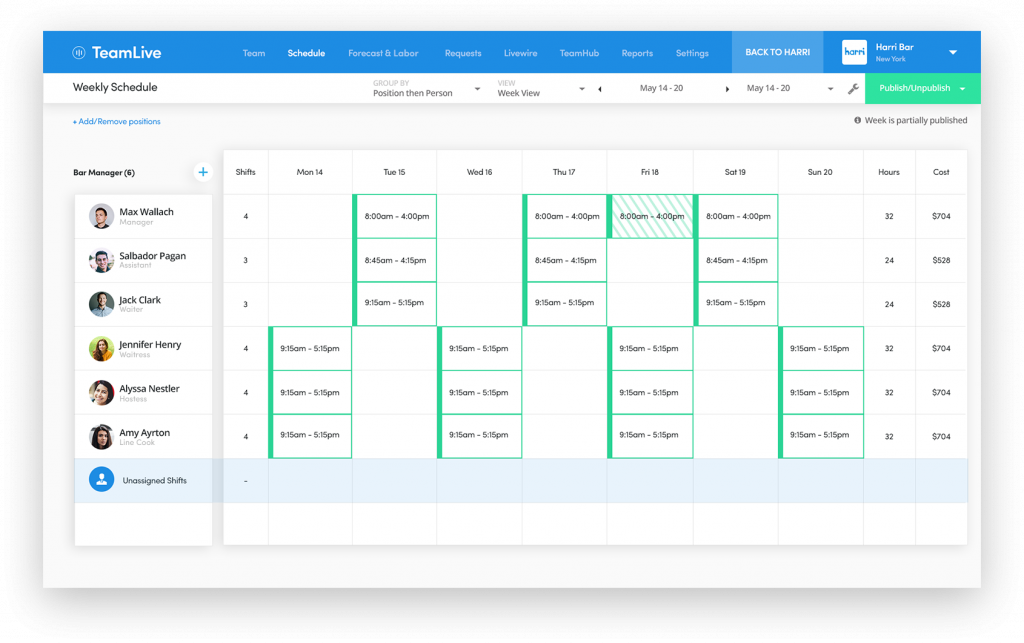Staff Scheduling for High-Volume Service: Strategies and Solutions

- By Harri Insider Team | March 7, 2023
As a business owner, whether you’re a small or large business, one of your top challenges will be how to schedule staff properly. If you’re a service-based business, particularly in the hospitality field, you’ll face additional concerns because of the high volume. Decreasing staff turnover and meeting the demands of your customers can be avoided if you develop a workable scheduling strategy that provides solutions for the pitfalls you can face if you aren’t proactive.
How is High-Volume Staff Scheduling Different?
Scheduling staff is a balance between covering all the tasks with skilled workers and not overworking anyone, but high-volume businesses have extra things to consider. Their businesses may operate at longer hours each day, such as 24/7 versus 8–12-hour days. Services may be seasonal, so schedules change at different times of the month or year, and satisfying a larger pool of workers means that Human Resource teams and managers must pay attention to nuances on a different level.
High-volume service businesses have constant customer-facing positions, demanding heavier shift loads and larger teams, which means the scheduling manager spends more time ensuring everyone’s hours are fair and that they fit within their personal needs as well as that of the company. Overworked or unhappy employees may result in disgruntled customers, and if there aren’t enough workers in general, business output may suffer, which affects profitability.
There are also behind-the-scenes workers, equally important as the forward-facing staff. All these positions require the manager to be on top of multiple departments, to be organized and planning staff scheduling needs in advance, and to be flexible. More staff equals more time spent, so a good tool to have in your pocket is a solid staff schedule software platform that takes a lot of these tasks off your plate and keeps the business running smoothly.
The Challenges of Staff Scheduling
Even the most organized of businesses will face scheduling challenges. Here are a few examples of the most common when you’re a high-volume service business.
Managing a High Volume of Staff
Staffing any business requires some finesse, but when you have a large staff, that’s a lot of data to maintain and manage. The more people you hire, the more balance that will be required, and when you serve a high number of customers, it can become overwhelming if you don’t have a handle on it.
Balancing Employee and Business Needs Every Day of the Week
It may seem obvious that you need more people working when your business is busy, but what about when it’s slow? Do you have tasks that need to be done on a regular basis regardless of how many customers you may have that day? Staffing isn’t just about manning all stations when it’s busy but taking advantage of the downtime to do things like stock shelves or clean. The pandemic threw some additional obstacles our way, requiring increased cleaning protocols and more detailed steps to ensure both employee and customer safety.
Compliance with Labor Laws and Regulations
City, state, and federal labor laws are something that all Human Resource teams and hiring managers in the hospitality industry should thoroughly know regarding labor compliance. Breaking a law can result in heavy fines to the business, and employees may leave if they feel their rights are being abused. Each city and state may have different legal requirements for employees, and if your business has multiple locations, you will need to be aware of the laws for each of them. Examples of areas that may differ would be how many hours a person can work per day, the age of an employee working in a specific department (such as an establishment that serves alcohol), what constitutes overtime, when breaks must be taken, or how long they must be. When you schedule staff, you can have a lot of things to consider.

Top Strategies for Effectively Scheduling Staff
Constantly Monitor Your Staffing Needs
Labor forecasting can be a very helpful tool to understand your staffing needs. Properly done, this data will allow you to see when you need what positions the most. For example, a restaurant may be very slow on midweek mornings, but business picks up on Friday mornings as tourists arrive in town, and it stays heavy throughout the weekend. Combine historical metrics with seasonal trends, and you can ascertain more accurately how many people in each position you’ll need for how many hours a day, so you provide excellent service to customers without spending more on staffing than is necessary. Effectively staggering your workload in accordance with your busiest hours is a fine line but when achieved delivers everyone the best service available without costing your business money.
Track and Balance Staff Availability
Every good manager knows that employees are more than just workers; they are people with families, lives outside of work, and career goals. Managers need to know enough about this so they can divvy up hours to those who want them, providing those who desire a higher workload to get those hours while not expecting too much from those who wish to remain at a part-time level. Tracking this for each employee will allow you to schedule staff within their availability, creating fewer schedule changes for you and them and decreasing the possibility that workers will quit because their shifts are scheduled for hours or days they cannot work.
In addition to tracking consistent information, it is also necessary to notate those who have requested a specific time away for a vacation or urgent personal need and to consider this information as far in advance as you know. Communication is critical, especially if this means you’ll need someone else to fill a shift they don’t usually work. Gaps like this are opportunities for managers to offer extra hours to those who may need them temporarily, or someone who is looking to move into a new role or move upwards within the company.
Match Your Employee Skills to the Best-Suited Positions
Every employee has strengths and weaknesses, and utilizing their strengths increases their productivity and job satisfaction. It also allows your business to thrive because happier employers do better work, enjoy coming to work, and they call out less. Customers also can tell the difference between a satisfied employee and an unhappy one, and it’s easy to avoid if employees are placed in roles for which they are trained and have the skills needed.
Listen to Feedback from Employees and Customers
Communication between you and your team is two-way. It is as important for you to listen to the feedback from your employees as it is for you to communicate your needs, requirements, and schedules to them. If they are unhappy with their schedule or workload, or their placement, this is something to consider and add to your employee tracking spreadsheet. A good employee may be happy in their role, but if they feel that their shift is understaffed, this is valuable information for you. This doesn’t mean that every complaint you hear will require changes on your part, but each one deserves thought and investigation to ensure you’re not missing something that may be negatively impacting your customers and employees.
Get Organized
There are many ways a business can create and maintain a staff schedule, from analog paper schedules to high-tech staff schedule software platforms. Some businesses use online calendar pages, or spreadsheets printed and hung on the wall, while others do it all online. Whichever option you choose, make sure it leaves you room to remember the employee needs and time-off requests mentioned above, and that it allows you to give your employees sufficient time in advance to know your schedule expectations while giving you time to make changes if a schedule doesn’t work for someone.
Your needs may be basic, or they may require help, and if you’re running into a time crunch or your schedules aren’t working, it may be time to consider taking advantage of one of those staff software options for seamless scheduling.
Scheduling Staff Software Solutions
If you’ve never used staff schedule software before, you’re going to be pleasantly surprised about the level of convenience and ease they offer you. They not only allow you to handle scheduling, weekly employee hours, time, and attendance, but they can also help you stay on top of hiring. Whether you’re replacing employees or growing your team, tracking candidates can be time-consuming. A platform like Harri can help with talent acquisition and applicant tracking, as well as the onboarding process once you’ve hired them.
Bonus – it’s easy to use! When you’re in the process of selecting candidates, you can move them easily from one step to another, such as gathering their information, moving them to a screening phone call, then an interview, and then onto hiring if you choose to bring them on board. Have all their data right in front of you when you need it.
Harri also allows for automating the scheduling process, eliminating redundancy of information input and results in saving you time while improving staff productivity. You will also be able to more easily comply with each location’s labor laws and regulations with less worry.
Intelligent Scheduling with Harri
In summary, effective staff scheduling is a critical step in running a profitable business with a productive and happy team. Employees who feel their needs are considered and respected stay longer with a business, and customers get the best treatment by employees happy to be at work and enjoying their role. Using a scheduling staff software like Harri can decrease, or eliminate those staff scheduling challenges that managers dread, and you’ll know that the schedule you post meets the needs of your customers while balancing your staff’s needs and workloads. We like to refer to it as intelligent scheduling. If you want to give Harri a try, reach out for a free demo. You may not realize how much time you can save until you have that time back in your own schedule!



















